Estimation of Apple Flowering Frost Loss for Fruit Yield Based on Gridded Meteorological and Remote Sensing Data in Luochuan, Shaanxi Province, China
Abstract
1. Introduction
2. Materials and Methods
2.1. Study Area
2.2. Field Data
2.3. Remote Sensing and Meteorological Data Acquisition and Preprocessing
2.4. Method
2.4.1. Extracting the Planting Years of Apple Orchards Based on Remote Sensing Time-Series Data
2.4.2. Extracting Information of Apple Orchards Based on Gridded Meteorological Data
2.4.3. Construction of Frost Loss Assessment Model and Accuracy Verification
3. Results
3.1. Extraction of Apple Orchard Planting Distribution
3.2. Identification and Verification of Apple Orchard Planting Years
3.3. Extraction of Meteorologically Derived Parameters Based on Gridded Meteorological Data
3.4. Assessment of Fruit Amount Reduction Ratio Due to Frost during Apple Flowering
4. Discussion
4.1. Evaluation of the Influence of Meteorological and Remote Sensing Factors in the MLR Model
4.2. Frost Loss Assessment of Apple Orchard under the Background of Frost Injury
4.3. Application Prospects for the Assessment of Fruit Amount Loss Based on Frost Injury Analysis
5. Conclusions
Author Contributions
Funding
Institutional Review Board Statement
Informed Consent Statement
Data Availability Statement
Conflicts of Interest
References
- FAO (Food and Agriculture Organization of the United Nations). FAOSTAT Production Database. FAO, 2018. Available online: http://www.fao.org/faostat/zh/#data/QC (accessed on 5 December 2020).
- Wang, N.; Wolf, J.; Zhang, F.-S. Towards sustainable intensification of apple production in China—Yield gaps and nutrient use efficiency in apple farming systems. J. Integr. Agric. 2016, 15, 716–725. [Google Scholar] [CrossRef]
- Qiu, M.J.; Liu, B.C.; Liu, Y.; Wang, K.Y.; Pang, J.Y.; Zhang, X.N.; He, J.N. Simulation of first flowering date for apple and risk assessment of late frost in main producing areas of northern China. Trans. Chin. Soc. Agric. Eng. 2020, 36, 154–163. [Google Scholar] [CrossRef]
- Cilia, C.; Panigada, C.; Rossini, M.; Meroni, M.; Busetto, L.; Amaducci, S.; Boschetti, M.; Picchi, V.; Colombo, R. Nitrogen Status Assessment for Variable Rate Fertilization in Maize through Hyperspectral Imagery. Remote Sens. 2014, 6, 6549–6565. [Google Scholar] [CrossRef]
- Guillamón, J.G.; Prudencio, Á.S.; Yuste, J.E.; Dicenta, F.; Sánchez-Pérez, R. Ascorbic acid and prunasin, two candidate biomarkers for endodormancy release in almond flower buds identified by a nontargeted metabolomic study. Hortic. Res. 2020, 7, 203. [Google Scholar] [CrossRef]
- Piao, S.L.; Liu, Q.; Chen, A.P.; Janssens, I.A.; Fu, Y.S.; Dai, J.H.; Liu, L.L.; Lian, X.; Shen, M.G.; Zhu, X.L. Plant phenology and global climate change: Current progresses and challenges. Glob. Chang. Biol. 2019, 25, 1922–1940. [Google Scholar] [CrossRef] [PubMed]
- Ge, Q.S.; Wang, H.J.; Rutishauser, T.; Dai, J.H. Phenological response to climate change in China: A meta-analysis. Glob. Chang. Biol. 2015, 21, 265–274. [Google Scholar] [CrossRef] [PubMed]
- Wang, H.J.; Wu, C.Y.; Ciais, P.; Penuelas, J.; Dai, J.H.; Fu, Y.S.; Ge, Q.S. Overestimation of the effect of climatic warming on spring phenology due to misrepresentation of chilling. Nat. Commun. 2020, 11, 1–9. [Google Scholar] [CrossRef]
- Guo, L.; Wang, J.H.; Li, M.J.; Liu, L.; Xu, J.C.; Cheng, J.M.; Gang, C.C.; Yu, Q.; Chen, J.; Peng, C.H.; et al. Distribution margins as natural laboratories to infer species’ flowering responses to climate warming and implications for frost risk. Agric. For. Meteorol. 2019, 268, 299–307. [Google Scholar] [CrossRef]
- Bascietto, M.; Bajocco, S.; Mazzenga, F.; Matteucci, G. Assessing spring frost effects on beech forests in Central Apennines from remotely-sensed data. Agric. For. Meteorol. 2018, 248, 240–250. [Google Scholar] [CrossRef]
- Driessche, R.V.D. Survival of coastal and interior Douglas fir seedlings after storage at different temperatures, and effectiveness of cold storage in satisfying chilling requirements. Can. J. For. Res. 1977, 7, 125–131. [Google Scholar] [CrossRef]
- Cittadini, E.D.; de Ridder, N.; Peri, P.L.; van Keulen, H. A method for assessing frost damage risk in sweet cherry orchards of South Patagonia. Agric. For. Meteorol. 2006, 141, 235–243. [Google Scholar] [CrossRef]
- Vitasse, Y.; Schneider, L.; Rixen, C.; Christen, D.; Rebetez, M. Increase in the risk of exposure of forest and fruit trees to spring frosts at higher elevations in Switzerland over the last four decades. Agric. For. Meteorol. 2018, 248, 60–69. [Google Scholar] [CrossRef]
- Sarron, J.; Malezieux, E.; Sane, C.A.B.; Faye, E. Mango Yield Mapping at the Orchard Scale Based on Tree Structure and Land Cover Assessed by UAV. Remote Sens. 2018, 10, 1900. [Google Scholar] [CrossRef]
- Parker, L.; Pathak, T.; Ostoja, S. Climate change reduces frost exposure for high-value California orchard crops. Sci. Total Environ. 2021, 762, 143971. [Google Scholar] [CrossRef]
- Bennie, J.; Kubin, E.; Wiltshire, A.; Huntley, B.; Baxter, R. Predicting spatial and temporal patterns of bud-burst and spring frost risk in north-west Europe: The implications of local adaptation to climate. Glob. Chang. Biol. 2010, 16, 1503–1514. [Google Scholar] [CrossRef]
- Wang, S.; Chen, J.; Rao, Y.H.; Liu, L.C.; Wang, W.Q.; Dong, Q. Response of winter wheat to spring frost from a remote sensing perspective: Damage estimation and influential factors. ISPRS J. Photogramm. Remote Sens. 2020, 168, 221–235. [Google Scholar] [CrossRef]
- Abd Razak, J.A.B.; Shariff, A.R.B.; bin Ahmad, N.; Sameen, M.I. Mapping rubber trees based on phenological analysis of Landsat time series data-sets. Geocarto Int. 2018, 33, 627–650. [Google Scholar] [CrossRef]
- Shi, C.X.; Pan, Y.; Gu, J.X.; Xu, B.; Han, S.; Zhu, Z.; Zhang, L.; Sun, S.; Jiang, Z.W. A review of multi-source meteorological data fusion products. Acta Meteorol. Sin. 2019, 77, 774–783. [Google Scholar] [CrossRef]
- Han, S.; Shi, C.X.; Jiang, Z.W.; Xu, B.; Li, X.F.; Zhang, T.; Jiang, L.P.; Liang, X.; Zhu, Z.; Liu, J.J.; et al. Development and progress of high resolution CMA land surface data assimilation system. Adv. Meteorol. Sci. Technol. 2018, 8, 102–108. [Google Scholar] [CrossRef]
- Zhu, Y.H.; Yang, G.J.; Yang, H.; Wu, J.T.; Lei, L.; Zhao, F.; Fan, L.L.; Zhao, C.J. Identification of Apple Orchard Planting Year Based on Spatiotemporally Fused Satellite Images and Clustering Analysis of Foliage Phenophase. Remote Sens. 2020, 12, 1199. [Google Scholar] [CrossRef]
- Geiss, C.; Pelizari, P.A.; Blickensdorfer, L.; Taubenbock, H. Virtual Support Vector Machines with self-learning strategy for classification of multispectral remote sensing imagery. ISPRS J. Photogramm. Remote Sens. 2019, 151, 42–58. [Google Scholar] [CrossRef]
- Kong, F.J.; Li, X.B.; Wang, H.; Xie, D.F.; Li, X.; Bai, Y.X. Land Cover Classification Based on Fused Data from GF-1 and MODIS NDVI Time Series. Remote Sens. 2016, 8, 741. [Google Scholar] [CrossRef]
- Fernandez, E.; Whitney, C.; Luedeling, E. The importance of chill model selection—A multi-site analysis. Eur. J. Agron. 2020, 119, 126103. [Google Scholar] [CrossRef]
- Fishman, S.; Erez, A.; Couvillon, G.A. The temperature dependence of dormancy breaking in plants: Mathematical analysis of a two-step model involving a cooperative transition. J. Theor. Biol. 1987, 124, 473–483. [Google Scholar] [CrossRef]
- Kearns, M.; Ron, D. Algorithmic Stability and Sanity-Check Bounds for Leave-One-Out Cross-Validation. Neural Comput. 1999, 11, 1427–1453. [Google Scholar] [CrossRef]
- Saltelli, A.; Tarantola, S.; Chan, K.P.S. A Quantitative Model-Independent Method for Global Sensitivity Analysis of Model Output. Technometrics 1999, 41, 39–56. [Google Scholar] [CrossRef]
- Shao, Y.; Lunetta, R.S.; Wheeler, B.; Iiames, J.S.; Campbell, J.B. An evaluation of time-series smoothing algorithms for land-cover classifications using MODIS-NDVI multi-temporal data. Remote Sens. Environ. 2016, 174, 258–265. [Google Scholar] [CrossRef]
- Guo, L.; Dai, J.H.; Wang, M.C.; Xu, J.C.; Luedeling, E. Responses of spring phenology in temperate zone trees to climate warming: A case study of apricot flowering in China. Agric. For. Meteorol. 2015, 201, 1–7. [Google Scholar] [CrossRef]
- Leolini, L.; Moriondo, M.; Fila, G.; Costafreda-Aumedes, S.; Ferrise, R.; Bindi, M. Late spring frost impacts on future grapevine distribution in Europe. Field Crop. Res. 2018, 222, 197–208. [Google Scholar] [CrossRef]
- Di Gennaro, S.F.; Toscano, P.; Cinat, P.; Berton, A.; Matese, A. A Low-Cost and Unsupervised Image Recognition Methodology for Yield Estimation in a Vineyard. Front. Plant Sci. 2019, 10, 559. [Google Scholar] [CrossRef]
- Bai, T.C.; Wang, S.G.; Meng, W.B.; Zhang, N.N.; Wang, T.; Chen, Y.Q.; Mercatoris, B. Assimilation of Remotely-Sensed LAI into WOFOST Model with the SUBPLEX Algorithm for Improving the Field-Scale Jujube Yield Forecasts. Remote Sens. 2019, 11, 1945. [Google Scholar] [CrossRef]
- Zhang, Z.; Jin, Y.F.; Chen, B.; Brown, P. California Almond Yield Prediction at the Orchard Level With a Machine Learning Approach. Front. Plant Sci. 2019, 10, 809. [Google Scholar] [CrossRef] [PubMed]
- Miranda, C.; Santesteban, L.G.; Urrestarazu, J.; Loidi, M.; Royo, J.B. Sampling Stratification Using Aerial Imagery to Estimate Fruit Load in Peach Tree Orchards. Agriculture 2018, 8, 78. [Google Scholar] [CrossRef]
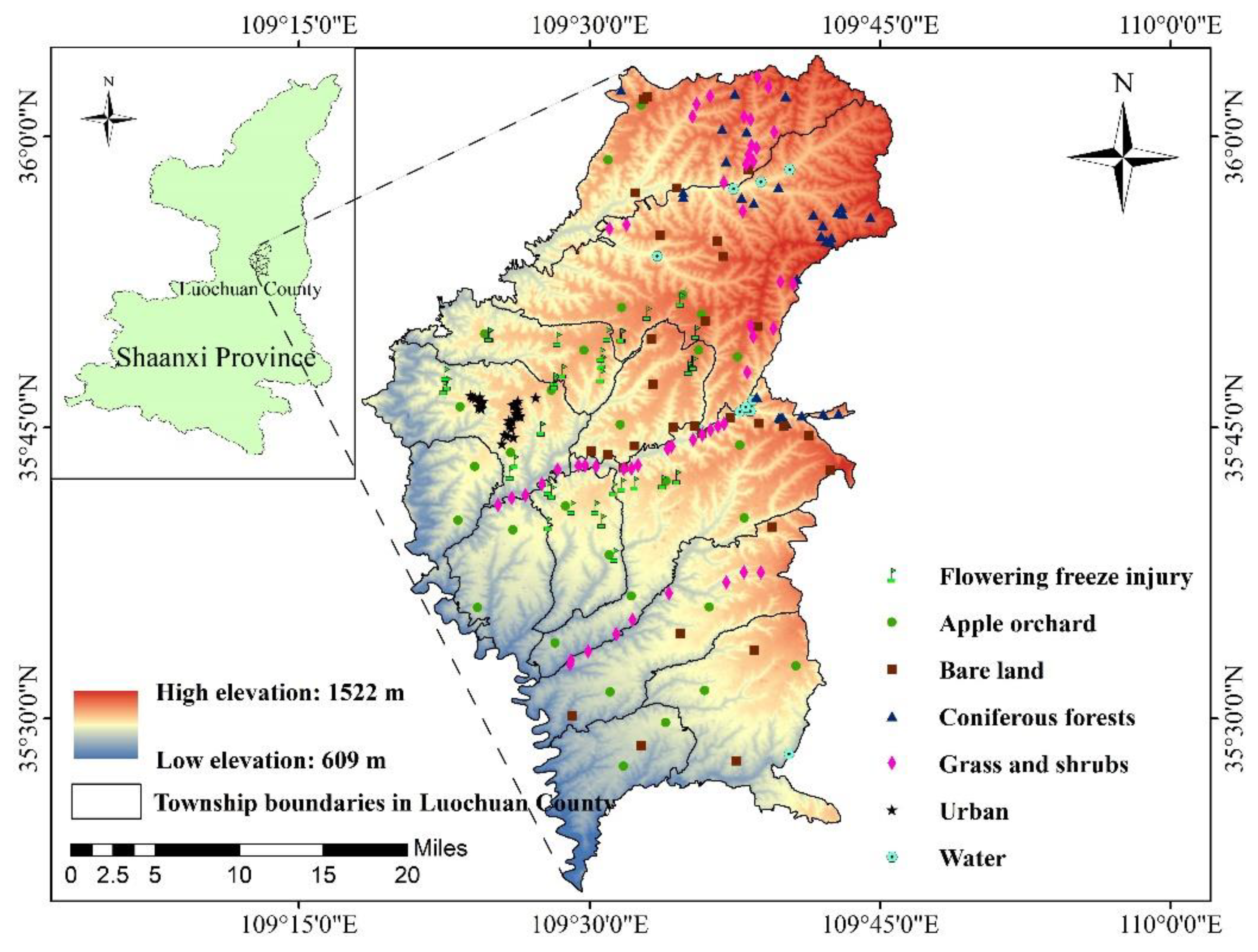

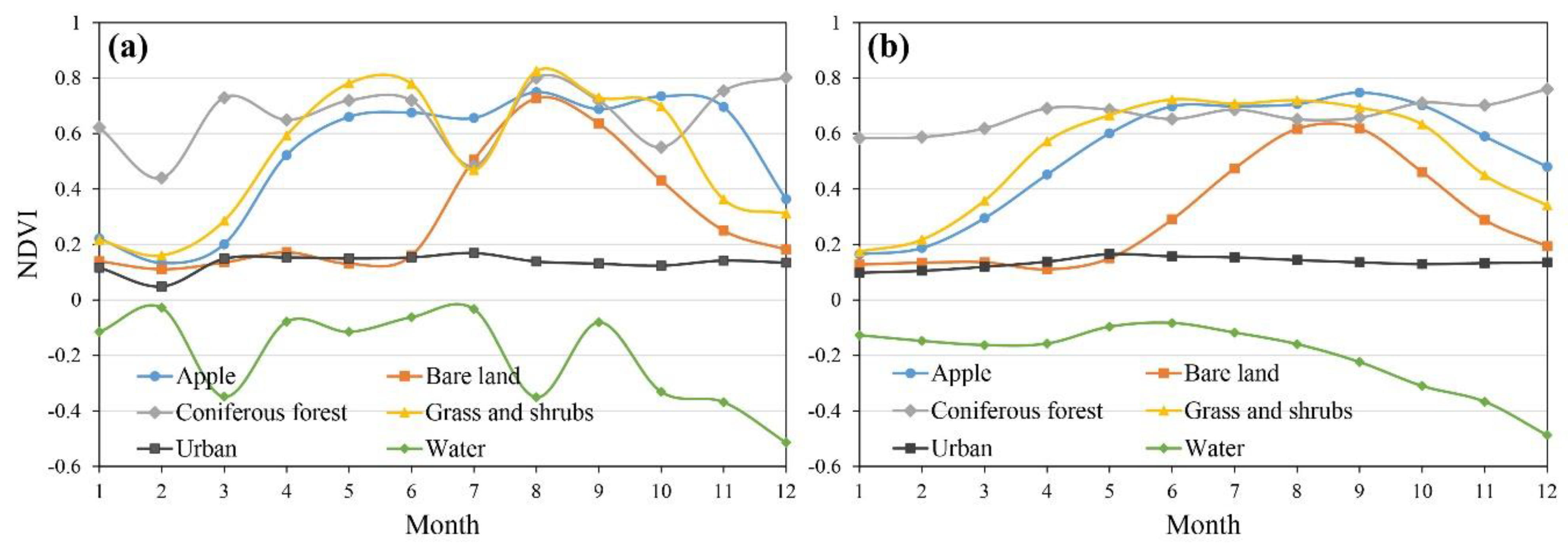
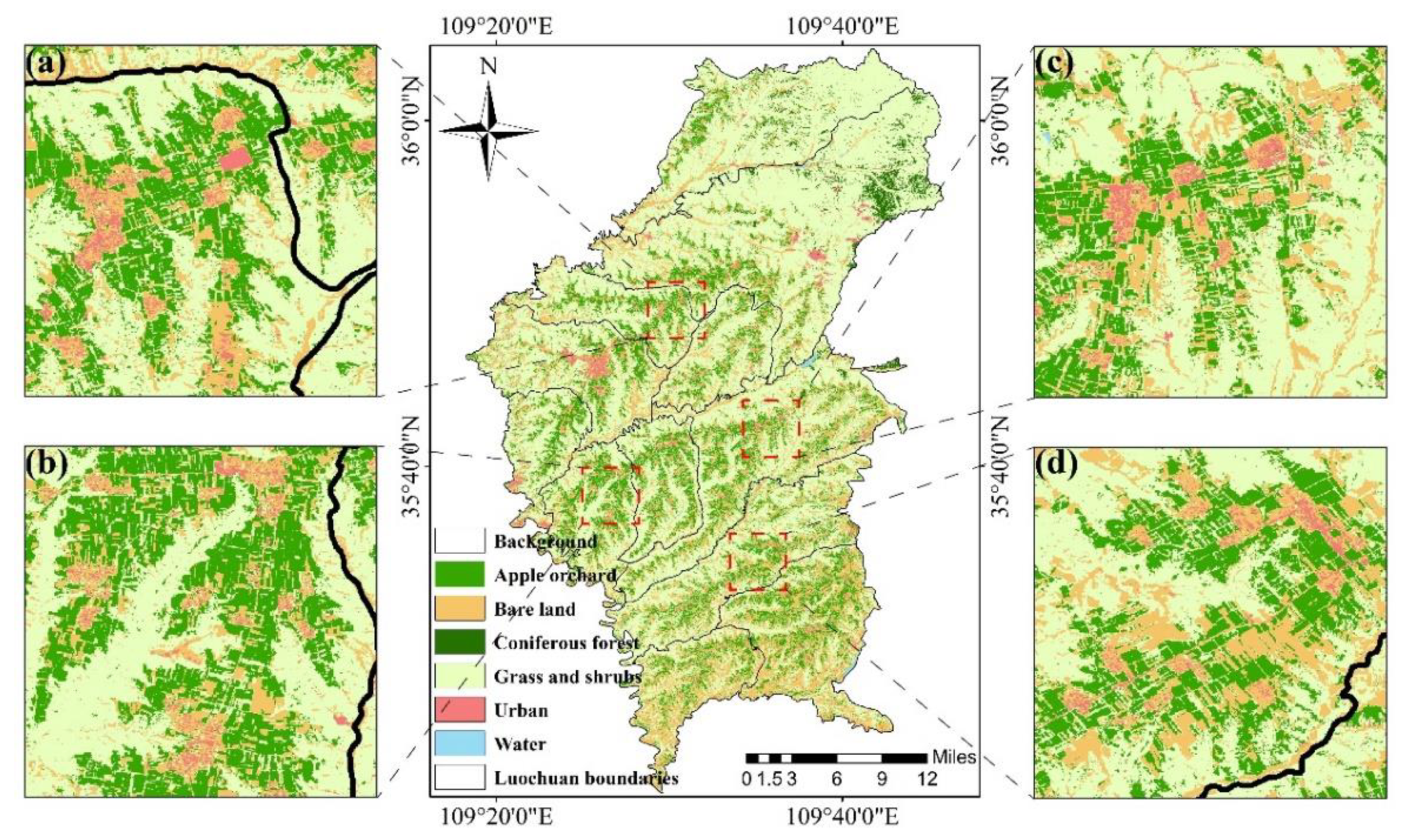

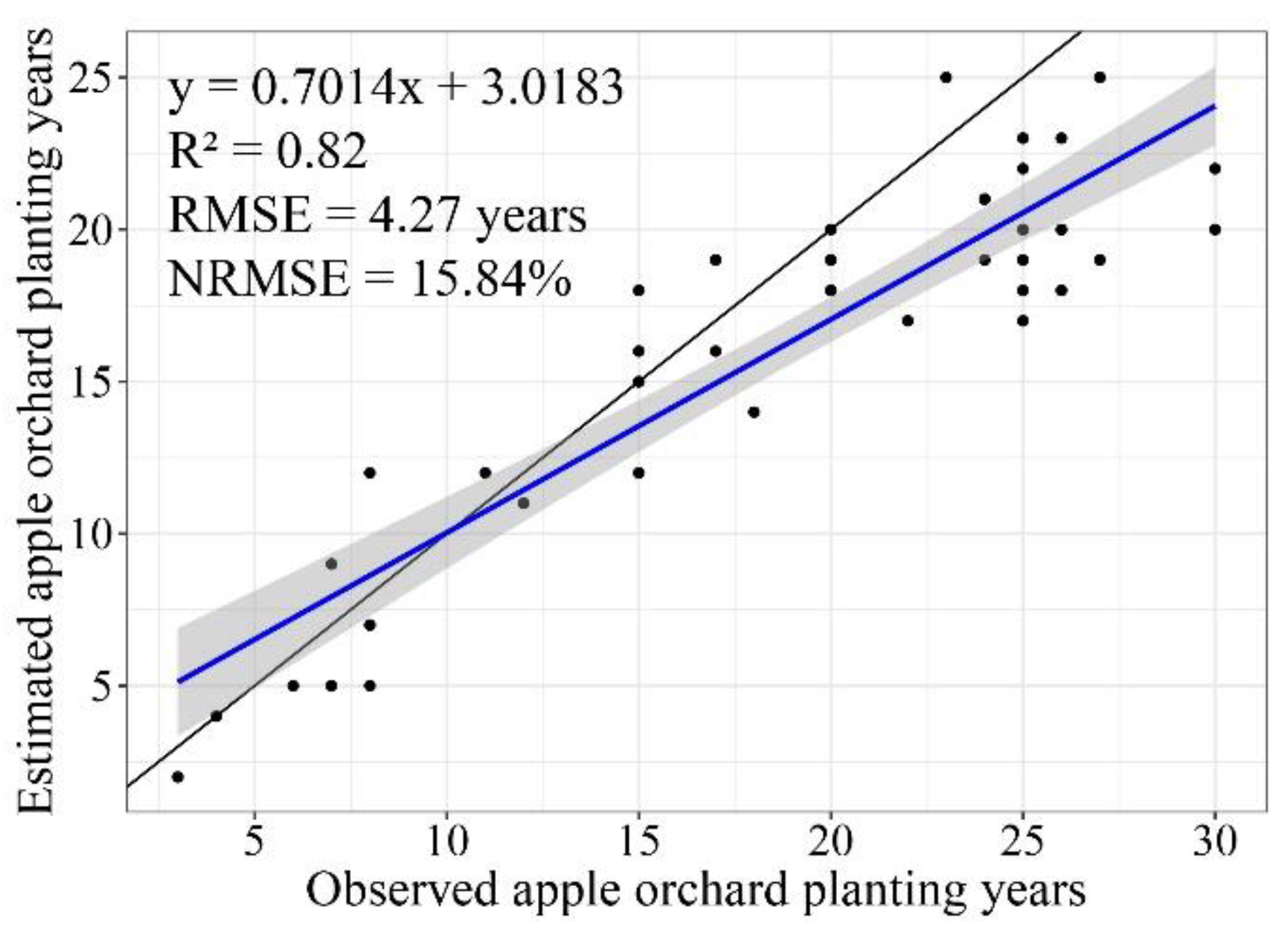

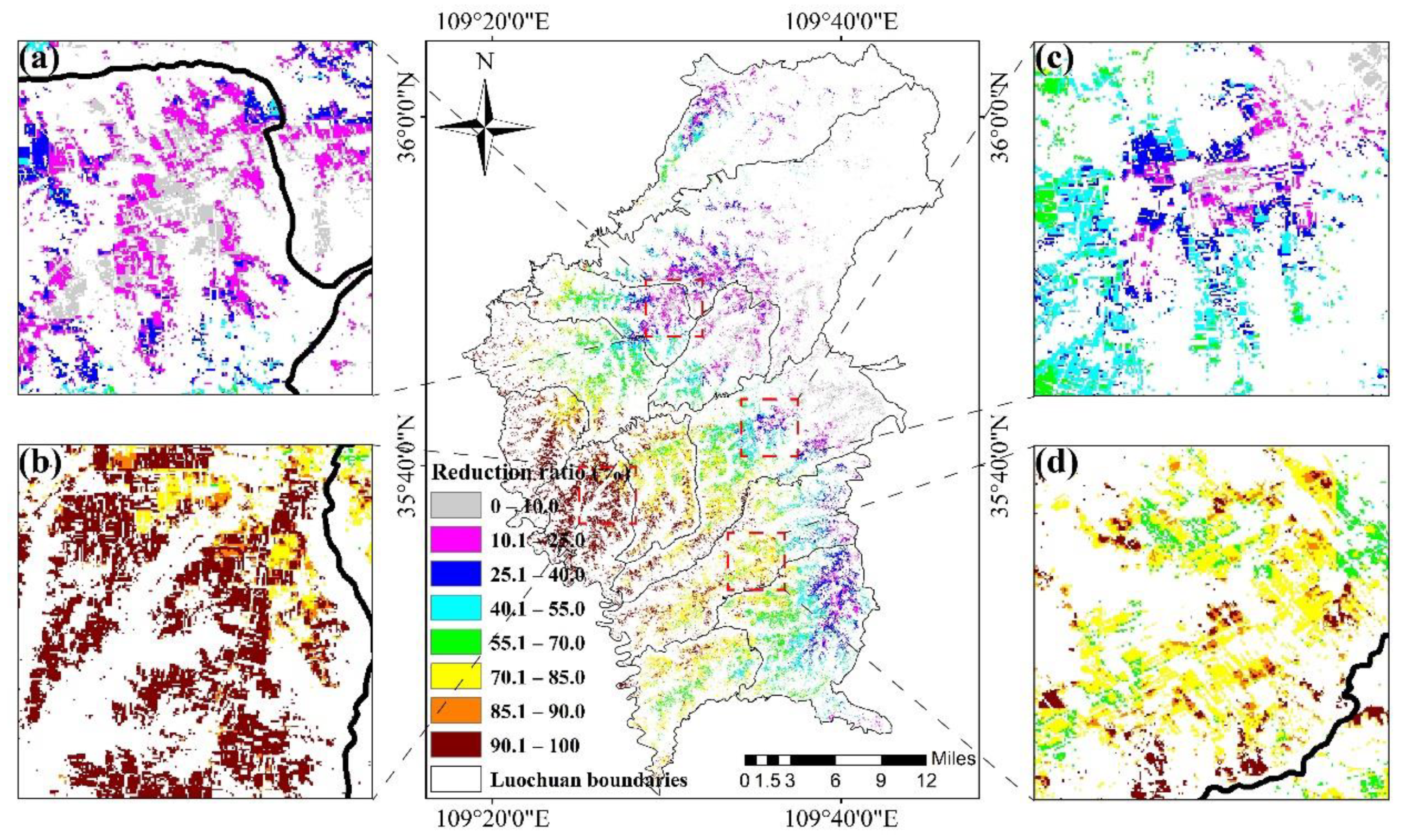
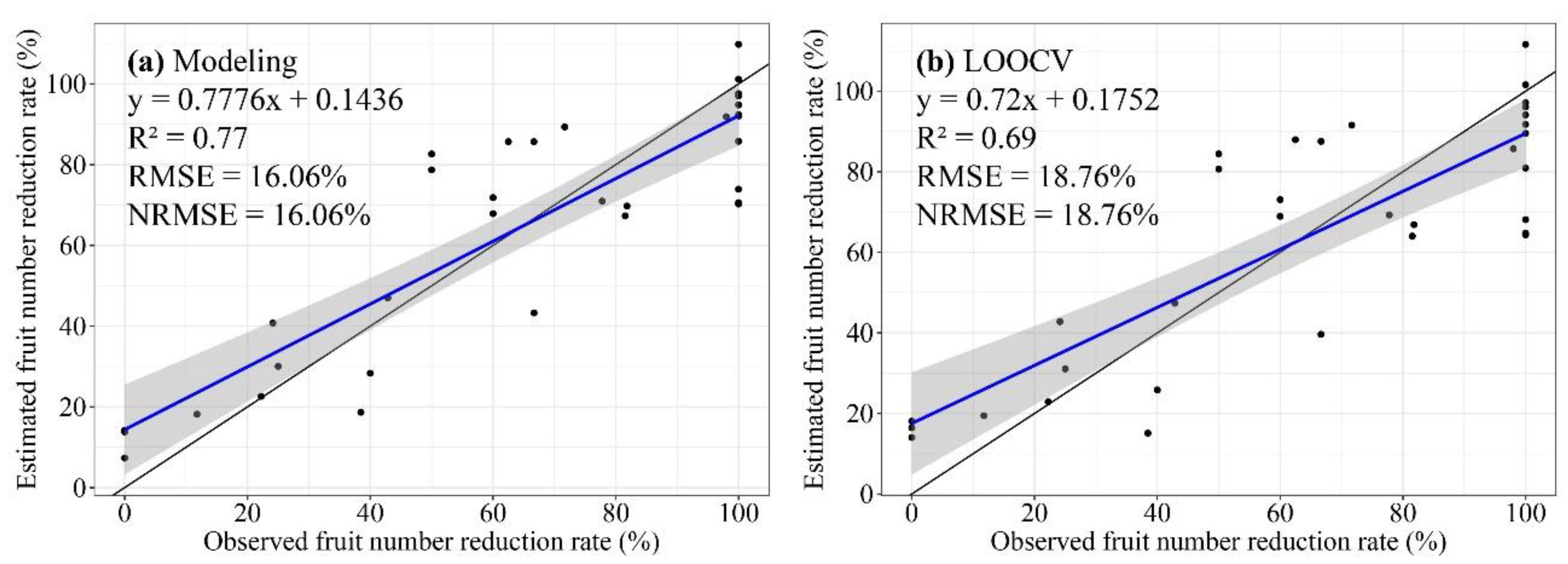
| Class | Prod. Acc (%) | User. Acc (%) |
|---|---|---|
| Apple Orchard | 98.97 | 98.91 |
| Bare land | 100.00 | 99.66 |
| Coniferous Forest | 100.00 | 100.00 |
| Grass and shrub | 99.01 | 99.16 |
| Urban | 99.66 | 100.00 |
| Water | 100.00 | 100.00 |
| Overall Accuracy | 99.38% (5978/6015) | |
| Kappa coefficient | 0.99 | |
| Parameters | Range (400 Samples) | First-Order Sensitivity Index | Total-Order Sensitivity Index |
|---|---|---|---|
| Planting years | 2–25 | 0.15 (10.86%) | 0.17 (11.62%) |
| Flowering days | 1–18 | 0.12 (8.78%) | 0.14 (9.45%) |
| Chill accumulation | 3.8–8.2 | 0.25 (18.45%) | 0.27 (18.50%) |
| Minimum temperature | 0.2–3.8 | 0.74 (54.19%) | 0.75 (52.15%) |
| Daily temperature difference | 17.2–18.6 | 0.10 (7.72%) | 0.12 (8.28%) |
Publisher’s Note: MDPI stays neutral with regard to jurisdictional claims in published maps and institutional affiliations. |
© 2021 by the authors. Licensee MDPI, Basel, Switzerland. This article is an open access article distributed under the terms and conditions of the Creative Commons Attribution (CC BY) license (https://creativecommons.org/licenses/by/4.0/).
Share and Cite
Zhu, Y.; Yang, G.; Yang, H.; Zhao, F.; Han, S.; Chen, R.; Zhang, C.; Yang, X.; Liu, M.; Cheng, J.; et al. Estimation of Apple Flowering Frost Loss for Fruit Yield Based on Gridded Meteorological and Remote Sensing Data in Luochuan, Shaanxi Province, China. Remote Sens. 2021, 13, 1630. https://doi.org/10.3390/rs13091630
Zhu Y, Yang G, Yang H, Zhao F, Han S, Chen R, Zhang C, Yang X, Liu M, Cheng J, et al. Estimation of Apple Flowering Frost Loss for Fruit Yield Based on Gridded Meteorological and Remote Sensing Data in Luochuan, Shaanxi Province, China. Remote Sensing. 2021; 13(9):1630. https://doi.org/10.3390/rs13091630
Chicago/Turabian StyleZhu, Yaohui, Guijun Yang, Hao Yang, Fa Zhao, Shaoyu Han, Riqiang Chen, Chengjian Zhang, Xiaodong Yang, Miao Liu, Jinpeng Cheng, and et al. 2021. "Estimation of Apple Flowering Frost Loss for Fruit Yield Based on Gridded Meteorological and Remote Sensing Data in Luochuan, Shaanxi Province, China" Remote Sensing 13, no. 9: 1630. https://doi.org/10.3390/rs13091630
APA StyleZhu, Y., Yang, G., Yang, H., Zhao, F., Han, S., Chen, R., Zhang, C., Yang, X., Liu, M., Cheng, J., & Zhao, C. (2021). Estimation of Apple Flowering Frost Loss for Fruit Yield Based on Gridded Meteorological and Remote Sensing Data in Luochuan, Shaanxi Province, China. Remote Sensing, 13(9), 1630. https://doi.org/10.3390/rs13091630







